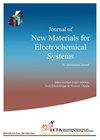Synthesis of Honeycomb-Shaped LiNi0.5Mn0.5O2 Using a Sol-Gel Method with Polymethylmethacrylate (PMMA) and Organic Surfactant
IF 0.6
4区 材料科学
Q4 ELECTROCHEMISTRY
Journal of New Materials For Electrochemical Systems
Pub Date : 2022-03-31
DOI:10.14447/jnmes.v25i1.a04
引用次数: 0
Abstract
Layered-structural LiNi0.5Mn0.5O2 has high discharge capacity, abundant availability, enhanced chemical stability, convenient environmental benignancy, and low cost. However, LiNi0.5Mn0.5O2 suffers from poor intrinsic rate capability due to its poor ionic conductivity (2.54 × 10-7 S/cm) and poor cycle stability owing to the volume change of the cathode materials during cycling. To address this issue, honeycomb-shaped LiNi0.5Mn0.5O2 was developed for lithium-ion batteries using a sol-gel method with spherical polymethylmethacrylate (PMMA) particles. PMMA particles provide spherical voids in LiNi0.5Mn0.5O2 cathode materials due to their relatively low decomposition temperature (< 350 °C). Honeycomb-shaped LiNi0.5Mn0.5O2 has a higher surface area (2.63 m2/g) than the LiNi0.5Mn0.5O2 (2.00 m2/g) produced by conventional sol-gel method. The initial discharge capacities of conventional nano LiNi0.5Mn0.5O2 and honeycomb-shaped LiNi0.5Mn0.5O2 are 151.9 mAh g-1 and 200.4 mAh g-1, respectively at 0.1 C. After 50 cycles at 1 C, honeycomb-shaped LiNi0.5Mn0.5O2 has a larger capacity retention than conventional nano LiNi0.5Mn0.5O2, measuring 67.9% and 58.8%, respectively. The superior electrochemical performance of honeycomb-shaped LiNi0.5Mn0.5O2 increases the effective surface area for Li-ion diffusion, leading to better rate capability, and buffers the volume change during Li+ion insertion/extraction, improving the cycling stability.聚甲基丙烯酸甲酯和有机表面活性剂溶胶-凝胶法合成蜂窝状LiNi0.5Mn0.5O2
层状结构的LiNi0.5Mn0.5O2具有高放电容量、丰富的可用性、增强的化学稳定性、方便的环境友好性和低成本。然而,LiNi0.5Mn0.5O2由于其较差的离子电导率(2.54×10-7S/cm)而具有较差的本征速率能力,并且由于阴极材料在循环过程中的体积变化而导致循环稳定性较差。为了解决这个问题,使用球形聚甲基丙烯酸甲酯(PMMA)颗粒的溶胶凝胶法开发了用于锂离子电池的蜂窝状LiNi0.5Mn0.5O2。PMMA颗粒由于其相对较低的分解温度(<350°C)而在LiNi0.5Mn0.5O2阴极材料中提供球形空隙。蜂窝形状的LiNi0.5Mn0.5O2比通过常规溶胶-凝胶法生产的LiNi0.5 Mn0.5O2(2.00m2/g)具有更高的表面积(2.63m2/g)。常规纳米LiNi0.5Mn0.5O2和蜂窝状LiNi0.5Mn0.5O2在0.1C下的初始放电容量分别为151.9mAh g-1和200.4mAh g-2。在1C下循环50次后,蜂窝状LiNi0.5 Mn0.5O2比传统纳米LiNi0.5 Mn 0.5O2具有更大的容量保持率,分别为67.9%和58.8%。蜂窝形状的LiNi0.5Mn0.5O2优异的电化学性能增加了锂离子扩散的有效表面积,导致更好的倍率能力,并缓冲了Li+离子插入/提取过程中的体积变化,提高了循环稳定性。
本文章由计算机程序翻译,如有差异,请以英文原文为准。
求助全文
约1分钟内获得全文
求助全文
来源期刊

Journal of New Materials For Electrochemical Systems
ELECTROCHEMISTRY-MATERIALS SCIENCE, MULTIDISCIPLINARY
CiteScore
1.90
自引率
0.00%
发文量
33
审稿时长
>12 weeks
期刊介绍:
This international Journal is intended for the publication of original work, both analytical and experimental, and of reviews and commercial aspects related to the field of New Materials for Electrochemical Systems. The emphasis will be on research both of a fundamental and an applied nature in various aspects of the development of new materials in electrochemical systems.
 求助内容:
求助内容: 应助结果提醒方式:
应助结果提醒方式:


